Learn to make your own easy Homemade Gluten Free Fettuccine Pasta with this simple recipe. You only need 4 ingredients for gf noodles.
Quit using the store-bought gluten-free pastas, and make your own homemade Gluten Free Fettuccine Pasta with this easy recipe!
Tender and soft fettuccine pasta is super easy to achieve with this gluten-free flour blend from Charlie's Table.
For years we have loved using the fresh artisan pasta that we get from Charlie's Table and we're very excited to find out that they were releasing their own pasta flour blend for everybody to be able to use to make your own homemade pasta creations – all gluten-free (and dairy free too?)
Just like the rest of our recipes, this pasta recipe is not just gluten free, but dairy free too!

Why make your own fresh gluten free pasta?
- It allows you to have complete control over the ingredients and ensure that there are no hidden allergens or preservatives. By using a gluten-free flour blend like Charlie's Table, you can rest assured that your pasta is safe for those with gluten sensitivities or celiac disease.
- Making your own pasta can be a fun and rewarding time in the kitchen. Plus, if you have kids, I'm sure they'll have fun making their new favorite gluten-free pasta.
- Homemade gluten-free pasta tends to have a much better creamy texture and flavor compared to store-bought alternatives. The tender and soft fettuccine noodles you can achieve with this recipe will truly elevate your pasta dishes to a new level.
- Making your own gluten-free pasta can be a cost-effective choice in the long run. While store-bought gluten-free pastas can be quite expensive (just like everything else gluten and dairy free for that matter), especially for those on a restricted diet, making your own allows you to save money without compromising on taste, quality, or safe ingredients.
- Plus with a simple recipe, you do not need a pasta machine! No expensive pasta maker necessary, just a good ol' rolling pin or pasta roller and pasta cutter, pizza cutter, or sharp knife is needed.
So why settle for store-bought gluten-free pastas when you can easily make your very own homemade Gluten Free Fettuccine Pasta? Give it a try and experience the joy of creating delicious, fresh, and gluten-free pasta in your own kitchen!
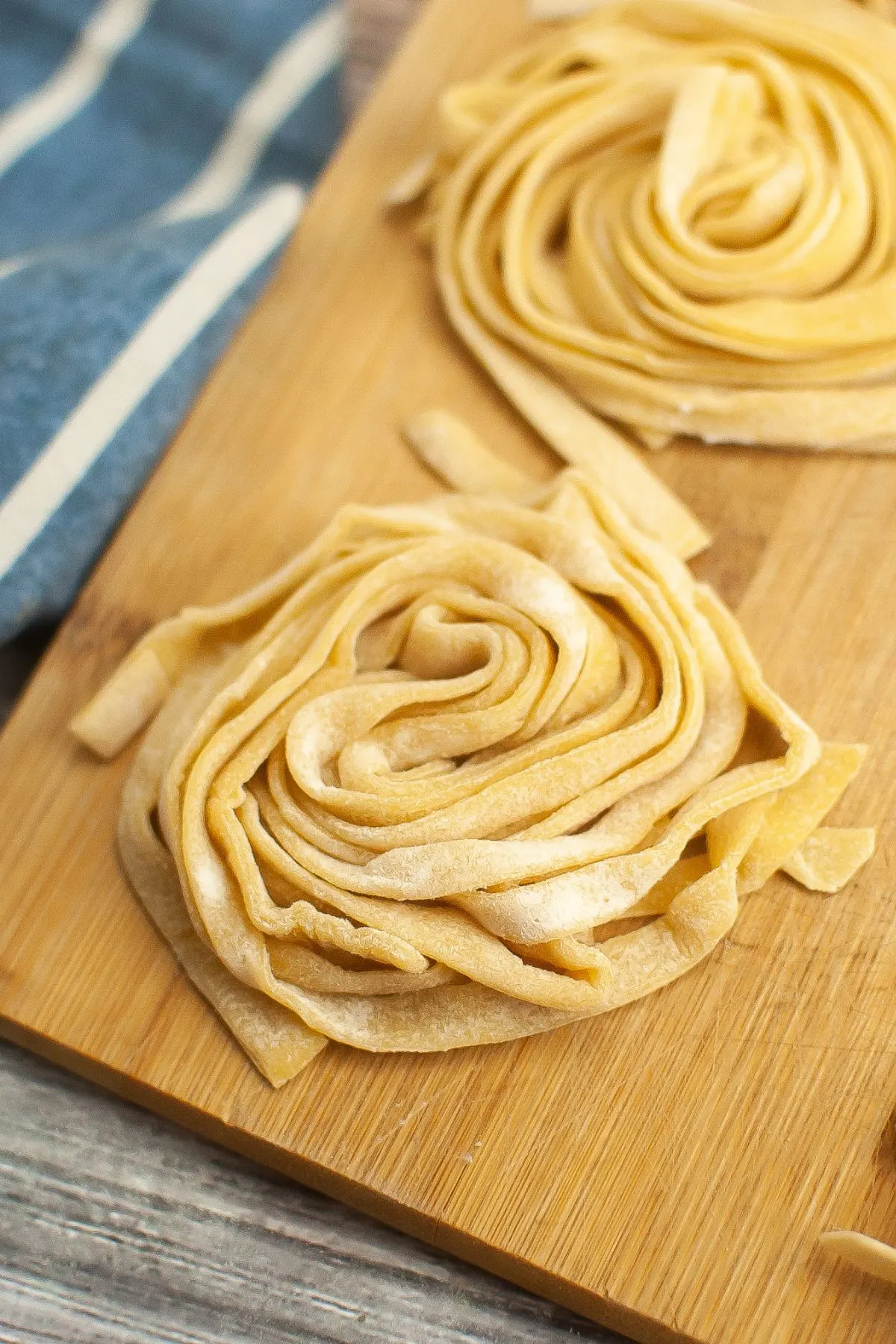
Simple Ingredients Notes
Here's a list of ingredients you need to make your own homemade fettuccine. In this section, you'll see our brand recommendations that we get asked for regularly.
Find quantities of the ingredients at the bottom of the page in the recipe card section, you'll see these ingredients paired with the instructions in a printable recipe card.
- Charlie's Table Gluten Free Pasta Flour- This is a flour blend that was formulated to make the perfect pasta
- Large Eggs- we only tested this with large eggs, anything smaller may make your dough too dry. We use farm fresh eggs but store bought will work fine.
- Salt- we use kosher salt, but feel free to use a different salt as you see fit
- Olive Oil - using a good quality olive oil, like Brightland Olive Oil, is key to a good flavored pasta

What's the best gluten free flour to use to make homemade gluten free pasta with?
We have only made this pasta recipe with Charlie's Table Pasta Flour. It's already formulated to "work". You don't have to worry about adding this or that to it since it's a blend that is made for pasta making.
According to their website, Charlie's Table Pasta Flour's ingredients are: "Gluten Free Flour Blend (Potato Starch, Millet Flour, Rice Flour, Tapioca Flour, Arrowroot), Xanthan Gum, Citrus Fiber, Salt, Spices."
Their pasta flour will have a similar texture and flavor of semolina pasta. Their pasta flour is certified gluten-free, plant-based, allergen-free and Kosher. You can find more about this product and their other products by visiting their website, checking out their FAQ section, and more.
You can buy Charlie's Table Pasta Flour directly from their website and you can use eatingglutenanddairyfree20 for 20% off your order!
Making Homemade Gluten Free Fresh Pasta Dough
Ditch the mixing bowl because we are making this pasta dough right on the kitchen counter (or other clean, flat work space). Pour 2 ¼ cups of your flour blend on your smooth work surface.
Use the back of a wooden spoon or bowl to create a 4-inch wide well in the center of your flour pile.
Crack the eggs into the well. Add olive oil and salt to the eggs.
Use a fork to beat the egg mixture together, gradually incorporating more flour from all of the sides of your well into the mixture. Continue to mix gently so you don't destroy your well. The flour will thicken the egg mixture and start to form a shaggy dough.
Use a bench scraper or your hands to fold the mixture together until you get a nice shaggy dough ball.
Use your hands to knead the dough for 10-15 minutes, or or until it is nice and smooth in texture and elastic like. If it's still too sticky, add 1 Tablespoon of the last of the flour at a time until it's a better consistency.
It's normal for the dough to seem dry or crumbly in the beginning, but the more you knead and work it, it should end up being slightly tacky and smooth.

Use your hands to shape the dough into a ball and wrap with plastic wrap tightly.
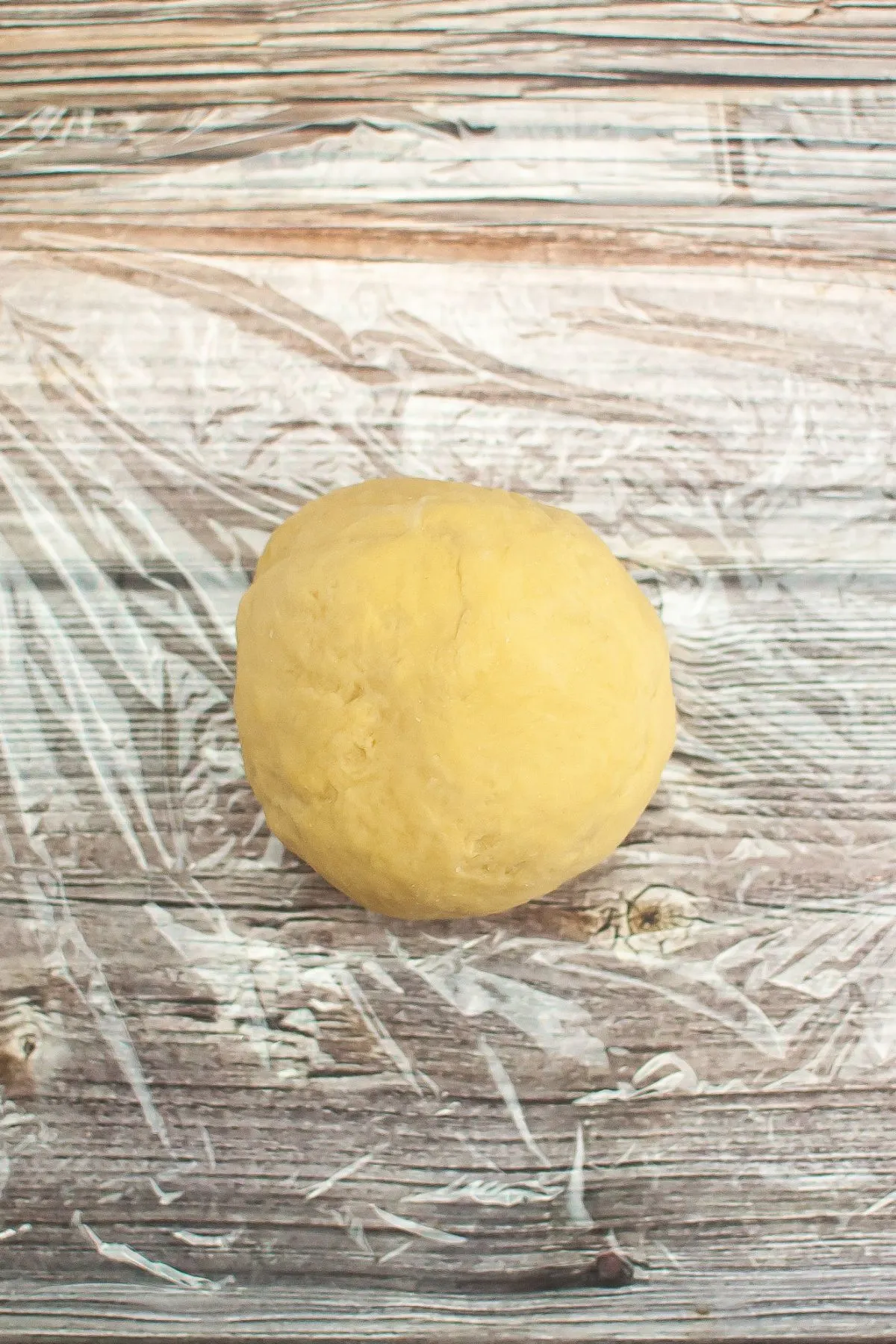
Let the dough rest at room temperature for a minimum of 30 minutes, but can rest for up to 3 hours. If you want to finish this later, you can refrigerate it for up to 24 hours. Let it come to room temperature before rolling it out though.
Rolling out your gluten free dough
Start by lightly flouring your work surface again.
If rolling dough that you just let rest at room temperature, divide it into 2-4 equal parts. If working with dough from the fridge, be sure it comes to room temperature before working with.
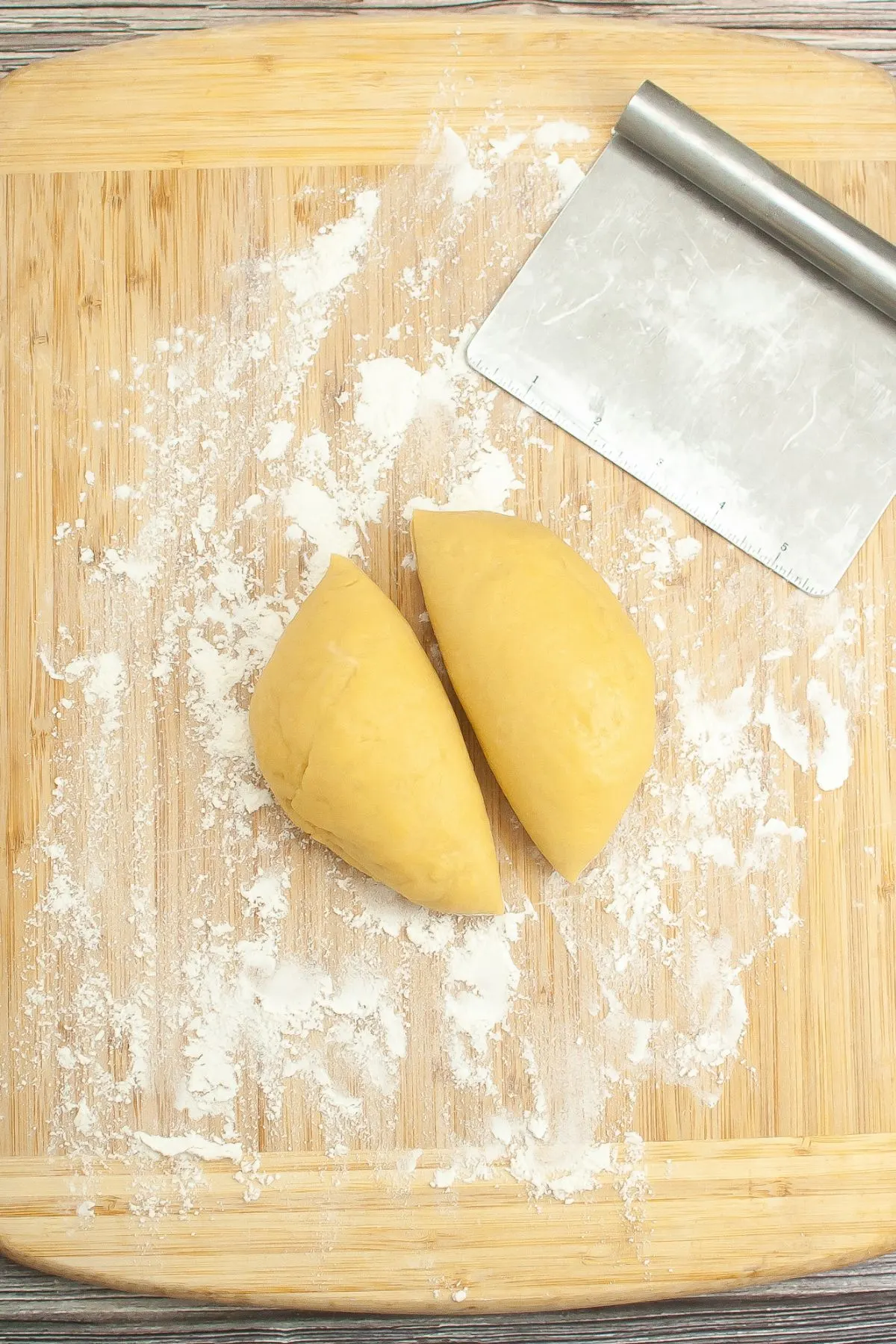
Work with one chunk at a time, use a rolling pin to roll out your dough into a ¼-inch thick rectangle pasta sheet. Sprinkle the rectangle with a little flour.

Cutting your dough into pasta shapes
Fold each sheet into 1-3" folds and cut into ⅛-inch pasta sections.
Once you've cut them, unravel or unroll each section to become cut noodles.

Cooking homemade gluten free pasta from scratch
Once you've cut your pasta, you can form small mounds or nests of noodles on a parchment-lined baking sheet and store or cook.
Boil a pot of water, salt it to taste and add your fresh pasta carefully. Stir as it cooks for about 3-5 minutes, or until tender.
Please keep in mind that the cooking time required can vary greatly depending on the size of your pasta noodles and the shape of the noodles that you cut. Start with less time, check the texture and doneness of the pasta and proceed as you see necessary.

Making fresh gluten-free pasta with pasta maker
Follow the instructions to make the gluten free pasta dough as you would if rolling by hand.
If you don't want to spend the time rolling it out by hand, and you have a pasta machine on hand then feel free to run your pasta through your pasta machine to flatten the dough out faster and make your pasta that way.
If your pasta maker has a cut setting, you can cut it using that as well.
Storage
Fresh made pasta is absolutely best on the day that you make it, in our opinion. However, you can choose to store leftovers of this great recipe if desired.
Store your leftover homemade pasta in an airtight container in the refrigerator for up to 3 days.
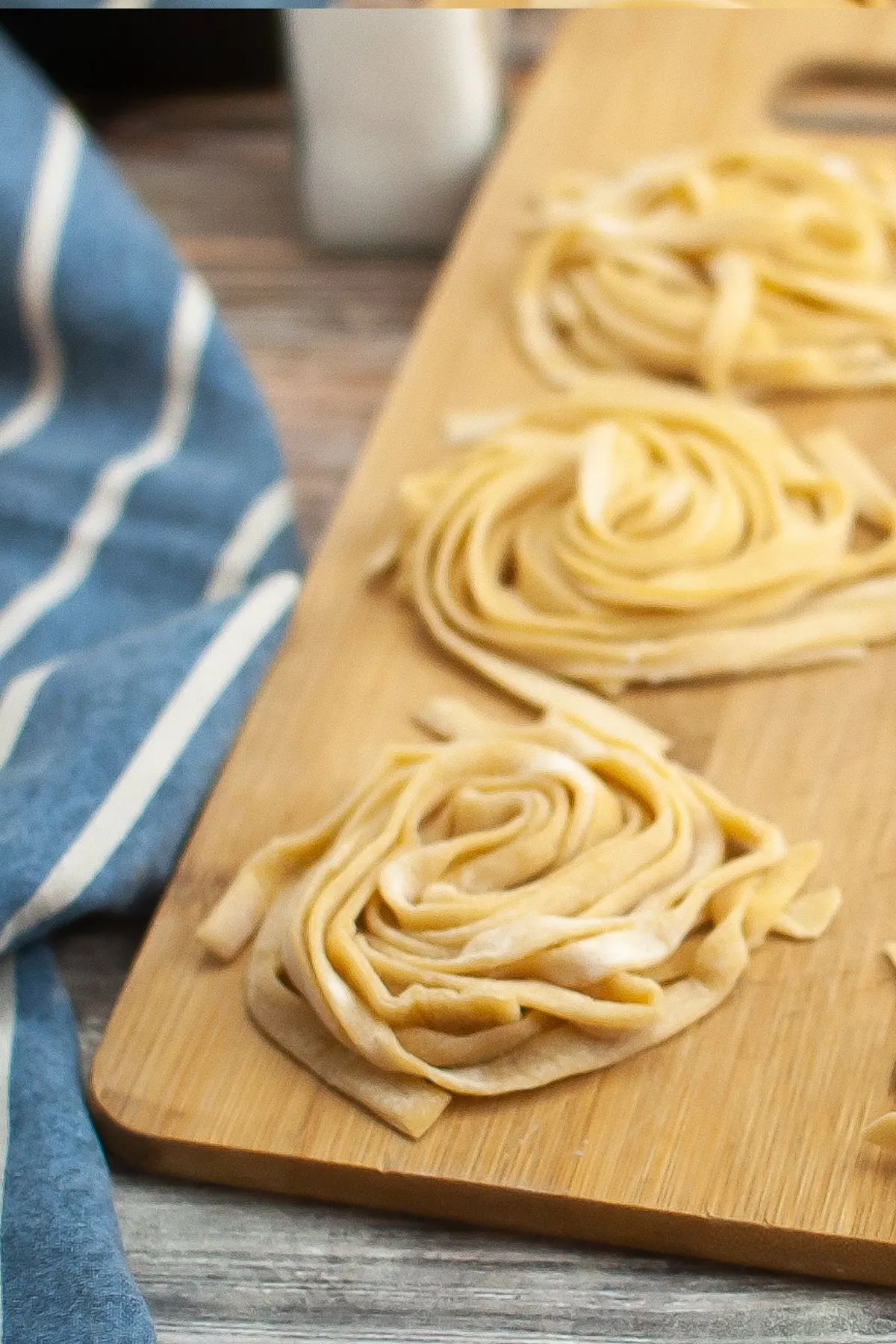
Do you have to cook fresh gluten free pasta immediately?
We have a hard time resisting the urge to not make the dough, cook it and eat it right then and there. But, if you want to make the dough, and store it in a wrapped ball in a container, it should last up to a day before it needs to be cooked.
Can you freeze gf pasta?
You can freeze your homemade pasta. We have tried freezing the uncooked pasta and have had great success with this wonderful recipe. You can make the pasta nests and flash freeze them before putting them into a freezer safe container for up to a month.
We have also had success in freezing pasta after we have cooked it al dente and then finish cooking just a bit more when ready to use again.
Cooking it al dente before freezing helps make sure that you don't have mushy pasta when you reheat it or finish it later.
Can you freeze unshaped gluten free pasta dough?
We don't see why you can't. If you just want to make the dough ball and try to freeze it, that should work also.
We suggest making the ball of dough and wrapping it tightly with cling wrap or plastic wrap and then putting it in a freezer safe zip top bag and removing any excess air.
You could store it for up to 1-2 months.
Thaw the dough before rolling it out into pasta sheets on a lightly floured surface and cutting it.
Do I need to add xanthan gum to this recipe?
We have only tested this recipe using Charlie's Table Pasta Flour. While we are sure you could make a gluten-free pasta recipe using other safe flour, we know this recipe works with Charlie's Table Pasta Flour.
This flour blend already contains xanthan gum so you do not need to add any more to your recipe.
If you're using a different flour blend then you need to check to see if your blend has it in it. Xanthan gum acts as a binding agent and helps keep your gluten free pasta from falling apart.
It helps give it that right texture that's similar to what gluten would do in traditional pasta. It's necessary to help form the dough properly.
Xanthan gum sometimes irritates people with food sensitivities. We have only made this recipe using a flour blend that contains xanthan gum. We suppose you could experiment and see if a blend that has a different gum like guar gum could work.
Maybe even something that has a different binding agent that you can tolerate, but we haven't tested it that way and you would be experimenting on your own.
As long as you can tolerate xanthan gum, for the best results, we suggest using a gluten free flour that has it in the blend. Again, we have only use Charlie's Table Pasta Flour, which we know is formulated well to make gluten free pasta with.
What do I do if my gluten free pasta dough is too wet?
Carefully sprinkle just a LITTLE bit more glour down and work it into your dough. Start at a very small amount and gradually add more until you get your desired consistency.
Can I make vegan homemade Fettuccine?
We tried making this with an egg replacement and it just didn't turn out. Two or three times we tried different replacers and have found that using that real egg is what is best with this specific recipe. If you're vegan or have an egg allergy, unfortunately, this recipe isn't for you.
Can you flavor this pasta?
Sure! While this simple gluten-free pasta has a bit of salt in it, you can add whatever other spices and seasonings you enjoy. Sprinkle some garlic powder on your dough ball if you're making some gluten-free fettuccine alfredo! Get creative and follow your tummy's desires.
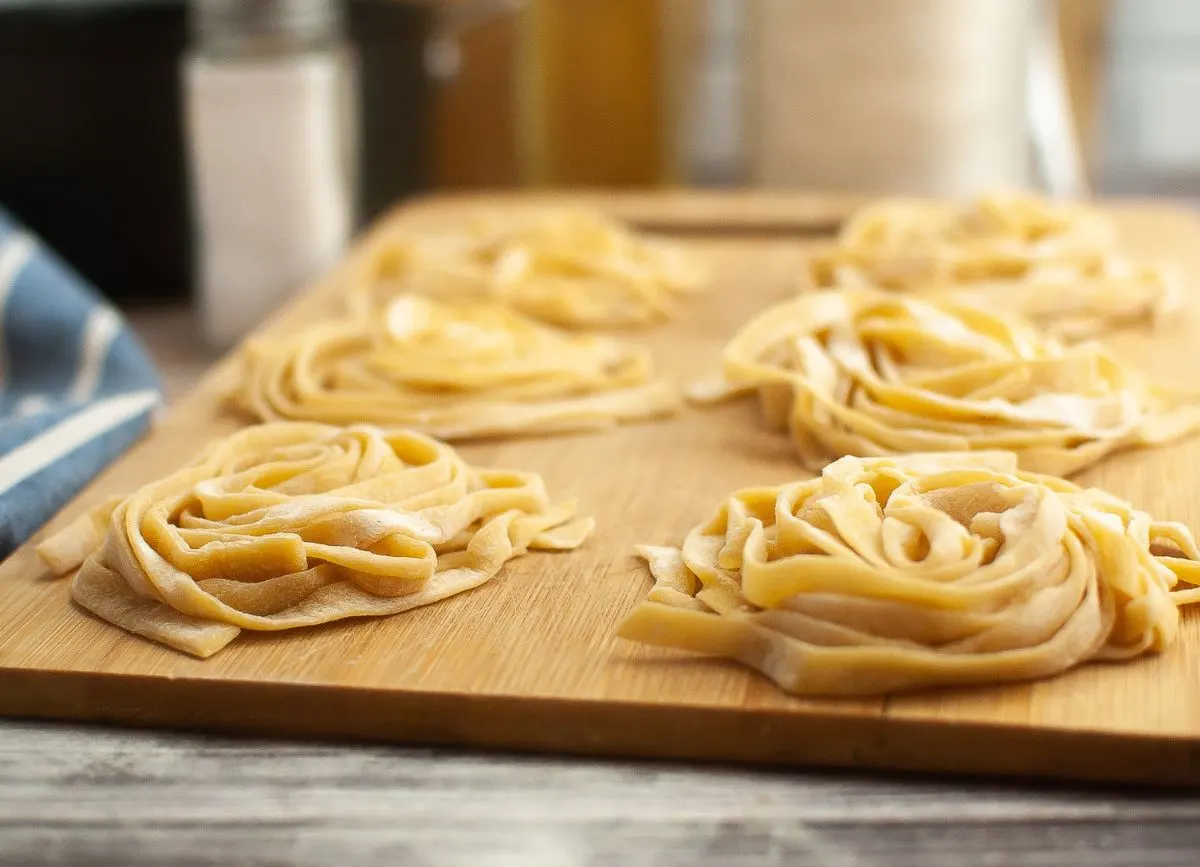
Why does my gluten free pasta keep breaking?
There can be a variety of different reasons that this keeps happening to you. One of the biggest issues is if you're working with dough that has become too dry.
You want your homemade dough to be hydrated, not soaking wet and not too brittle dry. Don't work too much flour into the dough as you're rolling and kneading it.
Make sure you're using appropriate sized eggs. We used large eggs. If you have smaller eggs than your dough could easily be too dry and may break quicker.
What to use this homemade pasta in?
Serve some homemade pasta with any of your favorite pasta sauces. Have you tried our Sundried Tomato Alfredo sauce? It would pair perfectly with homemade pasta.
Don't forget a traditional homemade alfredo sauce (dairy free too if you're like us), add some chicken and maybe even some peas and mushrooms for a tasty dinner.
You can use any red sauce or other favorite sauce that you prefer, or even make a gluten free carbonara using our gluten-free spaghetti carbonara recipe.
The options are endless, share with us in the comments what you made with your homemade gluten free pasta! Don't forget your favorite gluten free breadsticks or some of your fresh baked dinner rolls.
Homemade Gluten-Free Noodles Tips
- Don't overwork the dough.
- Don't skip the resting period when making the dough.
- You don't need to dry your pasta.
- Store the pasta appropriately so it stays fresh as long as possible.
If you want more Gluten-free pasta recipes- We have it on our list to try to make some homemade lasagna noodles next so we can amp up our gluten-free lasagna recipe that we shared years ago. That's a must make if you haven't had it yet!
Try our Spaghetti Pie, we love using other artisan pasta from Charlie's Table in that too.

Easy Homemade Gluten Free Fettuccine Pasta Recipe
Ingredients
- 2 ½ cups gluten free pasta flour see post for brand suggestion
- 3 large eggs
- ½ teaspoon salt
- 1 tablespoons olive oil
Instructions
Making Homemade Gluten Free Fresh Pasta Dough
- Ditch the mixing bowl because we are making this pasta dough right on the kitchen counter (or other clean, flat work space). Pour 2 ¼ cups of your flour blend on your smooth work surface.
- Use the back of a wooden soon or bowl to create a 4-inch wide well in the center of your flour pile.
- Crack the eggs into the well. Add olive oil and salt to the eggs.
- Use a fork to beat the egg mixture together, gradually incorporating more flour from all of the sides of your well into the mixture. Continue to mix gently so you don't destroy your well. The flour will thicken the egg mixture and start to form a shaggy dough.
- Use a bench scraper or your hands to fold the mixture together until you get a nice shaggy dough ball.
- Use your hands to knead the dough for 10-15 minutes, or or until it is nice and smooth in texture and elastic like. If it's still too sticky, add 1 Tablespoon of the last of the flour at a time until it's a better consistency.
- It's normal for the dough to seem dry or crumbly in the beginning, but the more you knead and work it, it should end up being slightly tacky and smooth.
- Use your hands to shape the dough into a ball and wrap with plastic wrap tightly.
- Let the dough rest at room temperature for a minimum of 30 minutes, but can rest for up to 3 hours. If you want to finish this later, you can refrigerate it for up to 24 hours. Let it come to room temperature before rolling it out though.
Rolling out your gluten free dough
- Start by lightly flouring your work surface again.
- If rolling dough that you just let rest at room temperature, divide it into 2-4 equal parts. If working with dough from the fridge, be sure it comes to room temperature before working with.
- Work with one chunk at a time, use a rolling pin to roll out your dough into a ¼-inch thick rectangle pasta sheet. Sprinkle the rectangle with a little flour.
Cutting your dough into pasta shapes
- Fold each sheet into 1-3" folds and cut into ⅛-inch pasta sections.
- Once you've cut them, unravel or unroll each section to become cut noodles.
Cooking homemade gluten free pasta from scratch
- Once you've cut your pasta, you can form small mounds or nests of noodles on a parchment-lined baking sheet and store or cook.
- Boil a pot of water, salt it to taste and add your fresh pasta carefully. Stir as it cooks for about 3-5 minutes, or until tender.
Notes
- Please keep in mind that the cooking time required can vary greatly depending on the size of your pasta noodles and the shape of the noodles that you cut. Start with less time, check the texture and doneness of the pasta and proceed as you see necessary.
- This recipe makes 1 pound of pasta, which is anywhere from 4-6 servings.
- The time required to make this recipe may vary depending on how long you let the dough rest and how long you cook the pasta for.
- Nutritional Facts will vary depending on brands that you choose. The info shared here is purely calculated via a computer with general info. Use an app that you can specify your specific gluten free safe brands to determine nutritional info.
Nutrition
Nutritional Disclaimer
These Nutritional Facts are ESTIMATED. Your actual nutritional info with this recipe may vary depending on the brands you choose. “Eating Gluten and Dairy Free” is not a registered dietician or nutritionist. The provided nutritional info above is based on a generic calculator, if you want more accurate info, use your nutritional calculator of choice where you can choose brands and get more info that way.
Make sure to follow us on Instagram and Pinterest to keep up with all our new recipes. Tag us if you make the recipe on IG or share your thoughts by commenting on the pin on Pinterest. If you try this recipe, feel free to give it 5 🌟 below
Eat Well and Feel Well
Pin It For Later

